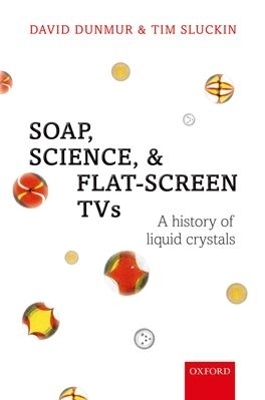
Soap, Science, and Flat-Screen TVs
Oxford University Press (Verlag)
978-0-19-954940-5 (ISBN)
The terms 'liquid crystal' or 'liquid crystal display' (LCD) are well-known in the context of flat-screen televisions, but the properties and history of liquid crystals are little understood. This book tells the story of liquid crystals, from their controversial discovery at the end of the nineteenth century, to their eventual acceptance as another state of matter to rank alongside gases, liquids and solids. As their story unfolds, the scientists involved and their works are put into illuminating broader socio-political contexts. In recent years, liquid crystals have had a major impact on the display industry, culminating in the now widely available flat-screen televisions; this development is described in detail over three chapters, and the basic science behind it is explained in simple terms accessible to a general reader. New applications of liquid crystals in materials, bio-systems, medicine and technology are also explained.
The authors' approach to the subject defines a new genre of popular science books. The historical background to the scientific discoveries is given in detail, and the personal communications between the scientists involved are explored. The book tells the story of liquid crystals, but it also shows that scientific discovery and exploitation relies on human interactions, and the social and political environments in which they work.
David Dunmur received his undergraduate and postgraduate degrees from the University of Oxford. After 3 years as a research fellow in the newly formed Department of Theoretical Chemistry, University of Bristol, he was appointed in 1968 as a lecturer in Chemistry at the University of Sheffield, where he became Head of the Department of Chemistry from 1993 to 1996. He was a Fulbright Scholar at the University of California in 1980. In 1999 he received the George Gray Medal from the British Liquid Crystal Society. From 1996 to his retirement in 2005, he was a research Professor in chemical physics (liquid crystals) in the School of Chemistry, University of Southampton. Tim Sluckin was born in London in 1951, and educated in Cambridge and Nottingham, where he received his Ph.D in 1975 for a thesis on the theoretical physics of liquid helium. After several postdoctoral appointments in the USA and in the UK, he was appointed a lecturer in applied mathematics at the University of Southampton (UK) in 1981. Since 1995 he has been Professor of Applied Mathematical Physics at the University of Southampton. He has also spent extended periods of sabbatical leave abroad, including spells in France (Grenoble), Italy (Milan) and Israel (Haifa). His main research interests have been in mathematical and physical aspects of liquid crystals, but he also has interests in other fluid phenomena. Another of his interests is mathematical population biology, including, in particular, problems to do with human prehistory. More recently he has also published significantly in the history of science.
1. Introduction: from carrots to displays ; 2. Crystals that flow: fact or fiction ; 3. Liquid crystals: where do they come from? ; 4. La Gloire Francaise ; 5. The meeting that wasn't and the meeting that was ; 6. The threads of life ; 7. Winds of war ; 8. Renaissance ; 9. An unlikely story ; 10. The light dawns in the west ; 11. The sun rises in the east ; 12. The new world of liquid crystals
| Erscheint lt. Verlag | 4.11.2010 |
|---|---|
| Zusatzinfo | 70 b/w line and halftone illustrations; 4pp colour plates section |
| Verlagsort | Oxford |
| Sprache | englisch |
| Maße | 161 x 237 mm |
| Gewicht | 772 g |
| Themenwelt | Sachbuch/Ratgeber ► Natur / Technik |
| Geschichte ► Teilgebiete der Geschichte ► Technikgeschichte | |
| Naturwissenschaften ► Chemie ► Physikalische Chemie | |
| Naturwissenschaften ► Geowissenschaften ► Mineralogie / Paläontologie | |
| Naturwissenschaften ► Physik / Astronomie ► Festkörperphysik | |
| Naturwissenschaften ► Physik / Astronomie ► Thermodynamik | |
| Technik | |
| ISBN-10 | 0-19-954940-0 / 0199549400 |
| ISBN-13 | 978-0-19-954940-5 / 9780199549405 |
| Zustand | Neuware |
| Haben Sie eine Frage zum Produkt? |
aus dem Bereich


